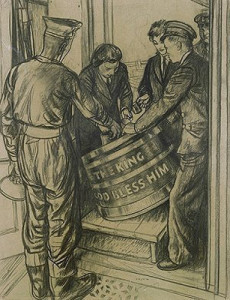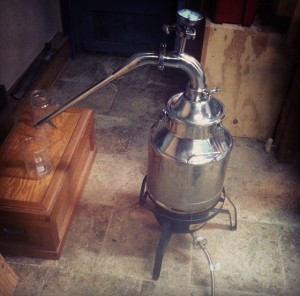Recipe and directions on how to make rum at home:
Rum is made from sugarcane byproducts, such as molasses, or directly from sugarcane juice. Rum first started being produced on Caribbean plantations in the 17th century. Run is commonly associated with the British Royal Navy. This association began in 1655 when the British captured Jamaica.
Yeast needs sugar nutrients in order to multiply and produce alcohol. Different regions of the world produce different grains and produce that can be used for fermenting alcohol. Distilled liquors get many of their distinct characteristics from the ingredients that are use. This is why there are so many different kinds of distilled alcohol.
The Russians would use potatoes to make vodka. The Scotch would use barley to make Whiskey. The Americans used corn to make corn whiskey and moonshine. The French would use grapes to make brandy. And the Caribbean plantations would use sugarcane to make Rum. Each spirit has its own distinct flavors and characteristics that are attributed to the distinct ingredients that are used, as well as aging process.
The distinct flavor and characteristics’ of rum come from the sugarcane that is used in fermenting, as well as the oak that it’s aged in. As such, when making rum you will need to use sugarcane byproducts such as cane sugar, molasses, or brown sugar. You will also need some toasted oak chips to age your rum.
Recipe for 10 gallons:
2 gallons of feed molasses
4 LBS of brown sugar
8 gallons water
Yeast: I use typically use a packet of Prestige distillers yeast.
You may also find it advantageous to substitute a gallon of water for a gallon of what was left if your still after your last run.
Step 1: Dissolve the sugar and molasses in a large steaming pot of water. You may have to use several pots if you don’t have one that’s large enough. You also want to be careful not to burn the molasses. You can avoid this by constantly stirring it.
Step 2: Pour your solution into you fermentation tank and let it cool down to 75 degrees Fahrenheit. You can add some cold water to help speed up the cooling process. One it has cooled down to 75 degrees you are ready to add your yeast.
Step 3: The fermentation process for this recipe should only take a couple of days. You can tell when the yeast is done fermenting when there ceases to be any bubbles emanating from your fermentation tank. You will want to wait for the yeast to settle to the bottom before adding it to your still. Remember that you don’t want to transfer the entire content of your fermentation tank to the still. Rather you will want to leave the yeast that has settled to the bottom. Distilling yeast can add some unwanted flavors.
Step 4: The distillation process for making rum is the same as any other spirit. See post on distillation. As with other spirits you will want to make your cuts. The cuts refers to the process of deciding what spirits you want to keep and what you want to throw out or redistill. See post on making cuts.
Step 5: Flavoring and aging: It is best to age your rum in an oak barrel. However, most people have neither the barrel nor the patience for this. As such, you should be able to get some toasted oak chips from your local home brewing supply shop. If not, you can find some oak and toast it yourself. I typically toast the oak by sprinkling a little distilled spirits on them before setting fire. I prefer using distilled spirits over other flammable products. No one wants their rum to be aged with gas infused oak chips. As with most things, moderation is key. You want to toast the oak chips until the edges are burnt.
After toasting your oak chips, you then will want to add them to you rum in a sealed Masson Jar. The warmer you keep the jar, the faster your rum will extract the flavors from the wood. You can try putting your jar of rum in the sunlight or by a heater. But be warned, distilled liquor is highly flammable. You may also wish to add a dash of brown sugar and/or cinnamon sticks to your run.
You will want to filter your rum in order to get rid of any oak residue before bottling or drinking it. For this you can either use a clean tee-shirt, cheese cloth, or a coffee filter.
Recipe taken from book published in 1829. Instructions on how to make rum:
To Make Jamaica rum.
To make Jamaica rum, it is necessary to procure some of the tops, or other parts of the sugar canes, and to put them in a still, in the proportion of a pound weight to two gallons of pure flavourless spirit, and one gallon of pure water. The distillation may be carried on by a brisk heat, provided there is a quantity of common salt, (in the proportion of an ounce to each gallon of liquid in the still), to prevent the mucilaginous matter from arising with the spirit. The product when rectified and coloured by burnt sugar, will possess every character of excellent rum.
To obtain rum from molasses.
Mix two or three gallons of water with one gallon of molasses, and to every 200 gallons of this mixture add a gallon of yeast. Once or twice a day the head as it rises is stirred in, and in three or four days, 2 gallons more of water is added to each gallon of molasses originally used, and the same quantity of yeast as at first. Four, five, or six days after this, a portion of yeast is added as before, and about an ounce of jalap root powdered, for in winter one ounce and a half), on which the fermentation proceeds with great violence, and in three or four days, the wash is fit for the still: one hundred gallons of this wash is computed to yield twenty-two gallons of spirit from one to ten over proof.
How to make rum


Thank you for the sensible critique. Me and my neighbor were just preparing to do a little research about this. We got a grab a book from our local library but I think I learned more clear from this post. I am very glad to see such great information being shared freely out there.
Thanks will get back on how it turns out
I live in a part of the us and have access to unlimited real sugar cane. Does anyone know much pure sugar cane I would need to make this recipe? I know I would crush the cane and can add this in the mash. Any ideas?
I want to make my own rum, I would like to make it with just molasses no sugar. what would be the ratio of molasses to water?
what is “feed molasses”?
what is the reason for the powdered jalap root ? looked up jalap root and it did not sound like something yo should use?